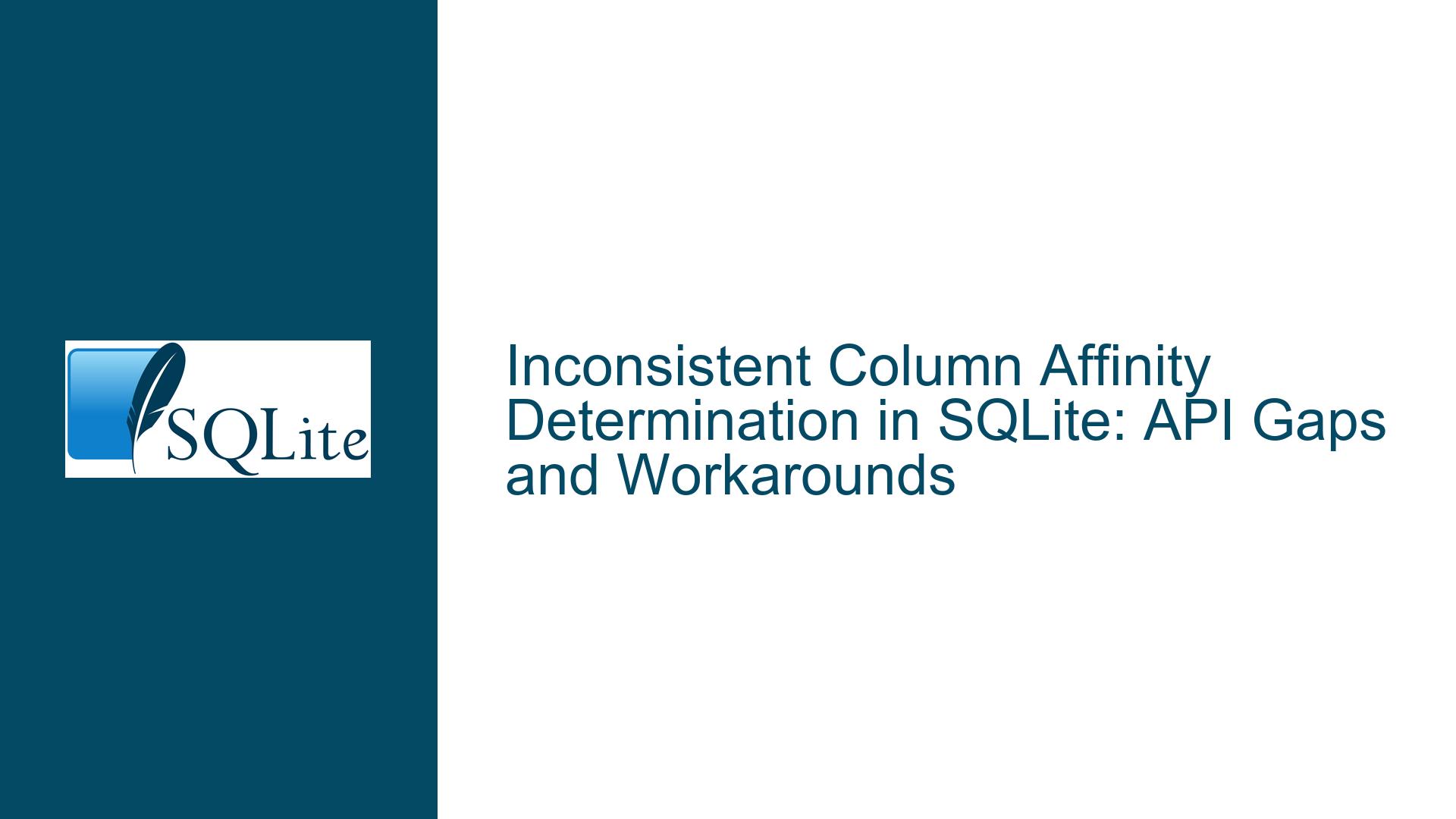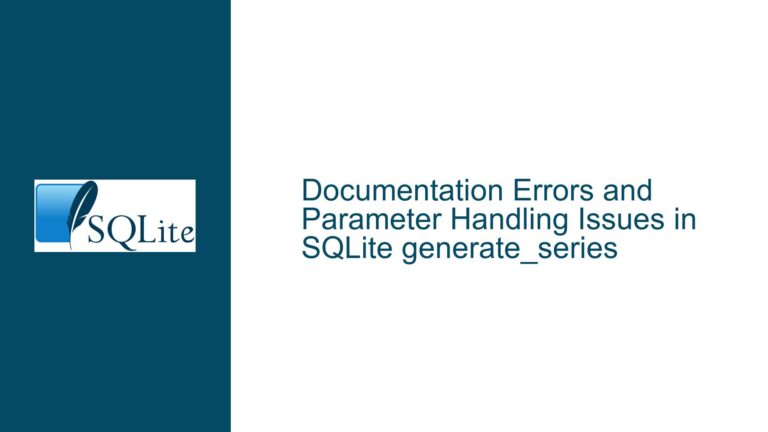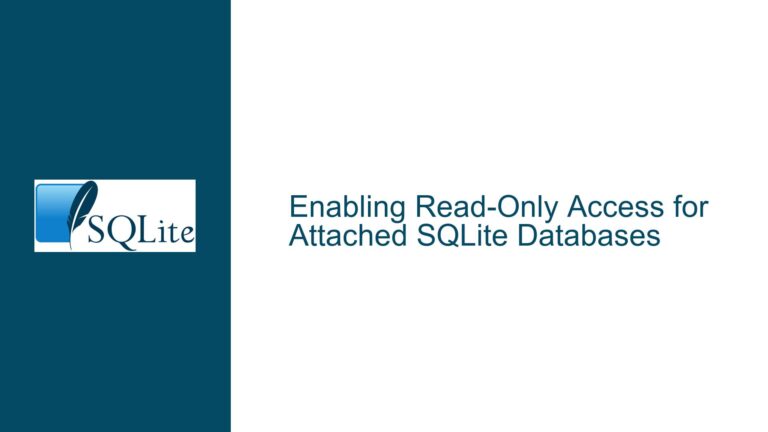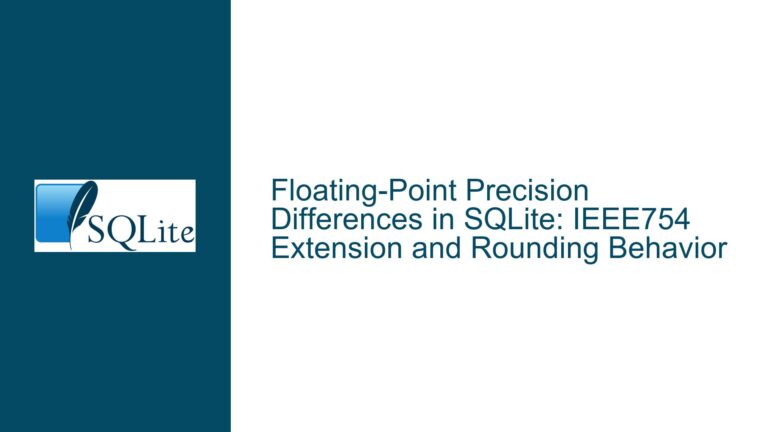Inconsistent Column Affinity Determination in SQLite: API Gaps and Workarounds
Understanding Column Affinity Mismatches in Schema Definitions and Queries
Issue Overview
Column affinity in SQLite governs how values are stored, compared, and sorted within a database. Unlike rigid data types in other database systems, SQLite uses dynamic typing with affinity hints derived from column declarations. The core issue discussed revolves around the inability to programmatically determine column affinity with reliability equivalent to SQLite’s internal mechanisms, particularly when using CREATE TABLE AS SELECT (CTAS) or interacting with virtual tables. Three critical pain points emerge:
Ambiguity in Affinity Determination Rules:
SQLite’s type affinity rules rely on pattern matching of declared column types. For example, a column declared asANYmay exhibit different affinities across SQLite versions or configurations. In non-STRICT tables,ANYhistorically defaulted toNUMERICaffinity but shifted toBLOBin recent versions. This shift is undocumented, leaving developers unaware of version-specific behaviors.Parser Idiosyncrasies and Type Name Interpretation:
The parser’s handling of non-standard type names (e.g.,ANY FLOATING POINT) introduces inconsistencies. Consider these declarations:CREATE TABLE t1 (a ANY FLOATING POINT); -- Resolves to INTEGER affinity CREATE TABLE t2 (a '' ANY FLOATING POINT); -- Resolves to NUMERIC affinity CREATE TABLE t3 (a [] ANY FLOATING POINT); -- Resolves to REAL affinityThe presence of non-identifier tokens (string literals, brackets) disrupts affinity determination. Developers cannot replicate this logic externally due to undocumented tokenizer behavior.
CTAS vs. Explicit Schema Definitions:
When materializing a view or query viaCREATE TABLE AS SELECT, SQLite assigns affinity based on expression evaluation rather than declared types. For example:CREATE VIEW v1 AS SELECT CAST(x AS REAL) FROM tbl; CREATE TABLE ctas_tbl AS SELECT * FROM v1; -- Column affinity: REAL CREATE TABLE manual_tbl (x REAL); -- Column affinity: REAL (same as CTAS)While this appears consistent, virtual table wrappers or proxy layers cannot replicate CTAS behavior because they lack access to expression-derived affinity metadata. Existing APIs like
sqlite3_column_decltype()fail here because they return the declared type (e.g.,CAST(x AS REAL)) rather than the resolved affinity.
The absence of a dedicated API to retrieve expression-derived affinity forces developers to reverse-engineer SQLite’s internal logic—a fragile approach given undocumented parser behaviors and version-specific quirks.
Root Causes of Affinity Determination Instability and Ambiguity
Possible Causes
Evolution of Type Affinity Rules Without Backward Compatibility:
SQLite’s type affinity rules have evolved to accommodate features like STRICT tables. In STRICT mode,ANYis treated as a valid type withBLOBaffinity, whereas non-STRICT tables historically assignedNUMERICaffinity. Documentation gaps exacerbate confusion, as developers assume affinity determination is static across table types.Undocumented Tokenizer and Parser Behaviors:
The parser’s handling of type names involves tokenization rules that are not fully exposed. For instance:CREATE TABLE t (a "ANY" FLOATING POINT); -- Type name parsed as "ANY" (literal) CREATE TABLE t (a ANY FLOATING POINT); -- Type name parsed as "ANY"The first declaration treats
"ANY"as a string literal, bypassing affinity rules, while the second treatsANYas an identifier. Developers cannot predict this without access to tokenizer internals.Reliance on Unstable Declared Type Strings:
Thesqlite3_column_decltype()function returns the original declaration text, which may include non-standard syntax (e.g.,CAST(x AS REAL)). This string cannot be reliably parsed to infer affinity due to:- Expression complexity (e.g., nested functions, arithmetic).
- Version-specific parsing (e.g., handling of
ANYin SQLite 3.37 vs. 3.38). - Ambiguities in quoted vs. unquoted type names.
Undocumented Internal Affinity Assignment Logic:
SQLite’s internalsqlite3AffinityType()function applies heuristics not fully described in documentation. For example,ANYin non-STRICT tables now maps toBLOBaffinity, but this change was not explicitly noted in release notes, leading to silent breaks in applications.
Resolving Affinity Ambiguities: Testing Strategies, Workarounds, and Feature Requests
Troubleshooting Steps, Solutions & Fixes
Step 1: Verify Affinity Using SQLite’s Undocumented affinity() Function
SQLite includes a hidden affinity() function for internal testing. While unsupported, it can temporarily aid diagnostics:
.testctrl internal_functions 1 -- Enable internal functions in CLI
CREATE TABLE t (a ANY);
INSERT INTO t VALUES ('test');
SELECT affinity(a) FROM t; -- Returns 'blob' in SQLite ≥3.37 with STRICT tables
Caveats:
- This function is unavailable in public API builds.
- Its behavior may change without notice.
Step 2: Replicate CTAS Behavior for Virtual Tables
To mirror CREATE TABLE AS SELECT affinity in virtual tables:
- Create a shadow table via CTAS and inspect its schema:
CREATE TABLE proxy_table AS SELECT * FROM target_table WHERE 0; PRAGMA table_info(proxy_table);Extract the inferred affinity from the
typefield. - Use
sqlite3_declare_vtab()to define the virtual table schema dynamically.
Step 3: Handle STRICT Table Affinity Changes
For STRICT tables, affinity is fixed to declared types. Migrate non-STRICT schemas by explicitly specifying affinity:
-- Before (non-STRICT)
CREATE TABLE t (a ANY); -- Affinity: BLOB (SQLite ≥3.37)
-- After (STRICT)
CREATE TABLE t (a BLOB) STRICT; -- Explicit affinity
Step 4: Use Pragma Queries to Infer Affinity
The PRAGMA table_xinfo(table) command provides a type field reflecting the declared type. While imperfect, it can be parsed using the following heuristics:
- Rule 1: If the type contains
INT, affinity is INTEGER. - Rule 2: If the type contains
CHAR,CLOB, orTEXT, affinity is TEXT. - Rule 3: If the type contains
BLOBor is empty, affinity is BLOB. - Rule 4: If the type contains
REAL,FLOA, orDOUB, affinity is REAL. - Rule 5: Otherwise, affinity is NUMERIC.
Limitation: This does not account for expression-derived affinities (e.g., CTAS).
Step 5: Advocate for a Public sqlite3_column_affinity() API
File a feature request with the SQLite team citing:
- Use cases involving virtual table proxying.
- Inability to replicate CTAS behavior programmatically.
- Risks of reverse-engineering parser logic.
Step 6: Monitor Documentation and Version-Specific Changes
Subscribe to SQLite’s changelog and review commits affecting sqlite3AffinityType(). For example, the bbba322a094b19d9 commit clarified STRICT table behavior.
Step 7: Implement a Custom Affinity Inference Layer
For applications requiring stable affinity detection, implement a parsing layer that:
- Tokenizes
sqlite3_column_decltype()output. - Applies SQLite’s affinity rules while accounting for version differences.
Example (pseudo-code):
def infer_affinity(decl_type, sqlite_version):
decl_type = decl_type.upper()
if 'INT' in decl_type:
return 'INTEGER'
elif any(t in decl_type for t in ['CHAR', 'TEXT', 'CLOB']):
return 'TEXT'
elif 'BLOB' in decl_type or not decl_type:
return 'BLOB'
elif any(t in decl_type for t in ['REAL', 'FLOA', 'DOUB']):
return 'REAL'
elif sqlite_version >= (3, 37) and 'ANY' in decl_type:
return 'BLOB' # Post-3.37 behavior
else:
return 'NUMERIC'
Final Note: Until an official API is available, combining pragma queries, version-specific logic, and CTAS shadow tables offers the most reliable workaround.






